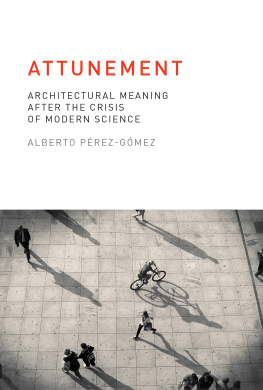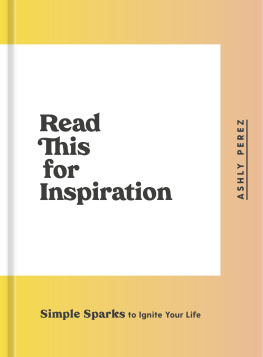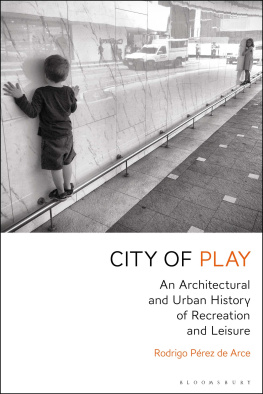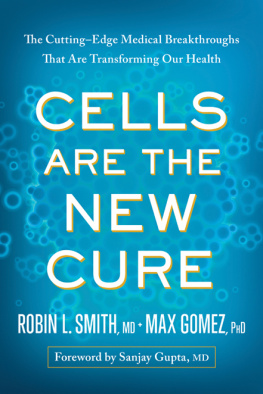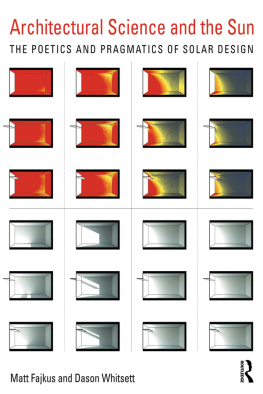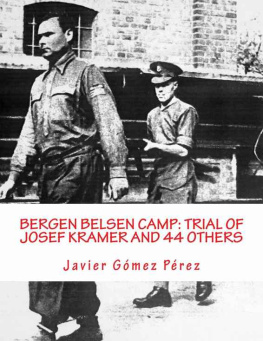Pérez-Gómez - Attunement: architectural meaning after the crisis of modern science
Here you can read online Pérez-Gómez - Attunement: architectural meaning after the crisis of modern science full text of the book (entire story) in english for free. Download pdf and epub, get meaning, cover and reviews about this ebook. City: London;Cambridge;Mass, year: 2016, publisher: MIT Press, genre: Romance novel. Description of the work, (preface) as well as reviews are available. Best literature library LitArk.com created for fans of good reading and offers a wide selection of genres:
Romance novel
Science fiction
Adventure
Detective
Science
History
Home and family
Prose
Art
Politics
Computer
Non-fiction
Religion
Business
Children
Humor
Choose a favorite category and find really read worthwhile books. Enjoy immersion in the world of imagination, feel the emotions of the characters or learn something new for yourself, make an fascinating discovery.
- Book:Attunement: architectural meaning after the crisis of modern science
- Author:
- Publisher:MIT Press
- Genre:
- Year:2016
- City:London;Cambridge;Mass
- Rating:3 / 5
- Favourites:Add to favourites
- Your mark:
- 60
- 1
- 2
- 3
- 4
- 5
Attunement: architectural meaning after the crisis of modern science: summary, description and annotation
We offer to read an annotation, description, summary or preface (depends on what the author of the book "Attunement: architectural meaning after the crisis of modern science" wrote himself). If you haven't found the necessary information about the book — write in the comments, we will try to find it.
Pérez-Gómez: author's other books
Who wrote Attunement: architectural meaning after the crisis of modern science? Find out the surname, the name of the author of the book and a list of all author's works by series.
Attunement: architectural meaning after the crisis of modern science — read online for free the complete book (whole text) full work
Below is the text of the book, divided by pages. System saving the place of the last page read, allows you to conveniently read the book "Attunement: architectural meaning after the crisis of modern science" online for free, without having to search again every time where you left off. Put a bookmark, and you can go to the page where you finished reading at any time.
Font size:
Interval:
Bookmark:

For Dalibor Vesely
in memoriam
Attunement
Architectural Meaning after the Crisis of Modern Science
Alberto Prez-Gmez
The MIT Press
Cambridge, Massachusetts
London, England
2016 Massachusetts Institute of Technology
All rights reserved. No part of this book may be reproduced in any form by any electronic or mechanical means (including photocopying, recording, or information storage and retrieval) without permission in writing from the publisher.
This book was set in Sabon by the MIT Press. Printed and bound in the United States of America.
Library of Congress Cataloging-in-Publication Data
Names: Perez Gomez, Alberto, 1949- author.
Title: Attunement : architectural meaning after the crisis of modern science
/ Alberto Perez Gomez.
Description: Cambridge, MA : The MIT Press, 2016. | Includes bibliographical
references and index.
Identifiers: LCCN 2015038400 | ISBN 9780262528641 (pbk. : alk. paper)
Subjects: LCSH: Architecture--Philosophy. | Architecture--Psychological
aspects.
Classification: LCC NA2500 .P454 2016 | DDC 720.1--dc23 LC record available at http://lccn.loc.gov/2015038400
ePub Version 1.0
Contents
Urban hygiene in modern planning: questions for psychosomatic health. The colloquial use of atmosphere and its recovery in recent architectural aesthetics. The phenomenological root of moods and their intersubjective manifestations. Moods and their relationship to the bodys expressiveness.
The integrated origins of architectural value in the European tradition. Pythagorean harmony and temperance in Vitruvian theory. Understanding musical analogy in architecture beyond formalistic extrapolations. Musical atmospheres in medieval practice and Renaissance theory. Transformations of traditional concepts in view of the baroque musicalization of the world. The unraveling of synesthesia as a cultural commonplace in the late seventeenth century and its consequences for architecture.
From Enlightenment Character Theory to Le Camus de Mzires. The place in-between characterized in words. Romantic Gemt and Stimmung . Stimmung in philosophy: concordant discord and opening toward death; the place where a fundamental relation to language arises. The articulation of constructed emotional space in the novel. The critical dimension of Stimmung : attunement with a hostile world. The theoretical project as alternative manifestation of character and Stimmung , from Piranesi and Boulle to Hejduk. Architectures expanded field: the arts, ephemeral structures, film, and the media. Continuities between romantic philosophy and surrealism: consequences in modern architecture. Case study: Kieslers Endless House.
The primacy of place (cosmic and cultural t pos ). The relationship between narrative and place: from myth to ritual, to narrative program connecting habits to place. The progressive displacement of narrative by scientific space in the eighteenth century. Lambert: perspective as truth granted by Gods generalized geometric space. From Newtons space in Boulle as limited infinity, the ultimate cosmic sacred architecture as coincidence of opposites, to Laplaces atheistic infinity and the cultural acceptance of Cartesian space as factual (subjectivity). Durand and the denial of the imperative of expression in architecture. Hedonism versus Stimmung . The automatic generation of signs in the Cartesian space of descriptive geometry: functionalism. The space of modernity and the concealment of place, from Schmarsow to Husserl and Merleau-Ponty. The return of place through space. From optical cinematic space to embodied depth in Le Corbusier. The role of poetic writing in Hejduks Victims . The poetic image and atmosphere.
Mind, body, and consciousness from Descartes to phenomenology. Developments in third-generation enactive cognitive science and neurophenomenology. The primacy of synesthesia (intermodality): the central and indispensable condition for architectures traditional harmony and modern Stimmung . Visual experience is not picturelike. The nature of lived timethe structure of the living present. Intersubjective place, emerging from empathy. The issue of presence in architecture: objects and events. Intertwinings with hermeneutic aesthetics: beauty as meaning in presence ( aisthsis ) and representation. Intersubjectivity, habit, gesture, and emerging language, and the flesh of the world. Stimmung as articulation between embodiment (habits) and language (between biological life, zoon , and human life, logon ).
I. The Voices ( Stimme ) of Architecture. Everything is language. The phenomenology of language. The complementarity of mathematical and rhetorical language in classical theory (Vitruvian dispositio and dcor contributing to communicative settings), in contrast with the antagonism between algorithmic and emerging natural languages characteristic of late modernity. The limitations of geometries in generating meaning after Durand, coupled with the imperative of aesthetic experimental innovation in modern architecture. Self-referentiality and its limitations. II. The Voice of the Architect. The linguistic basis of the imagination. The concept of narrative model. Productive fiction and the central role of metaphor to bring moods to presence. Representing architecture through poetic narrative: prefiguration or site, configuration or atmosphere, refiguration or program. The nature of plot in architecture, analogies to the novel (dramatic) and poetry (lyric): atmospheres for events articulated discursively and poetically. Architectural form: housing habits and enabling new sensorimotor skills and understandings: the ethical function of architecture.
The limitations and promises of digital software and media, in view of the primary linguistic imagination. The technical image: Flusser and Poncelet. Picturing forms of representation (digital and hybrid) and their modes of presence: perceptual experience is not pictorial, so architecture should not be identified with a mental picture. The propositional use of form in models and images, bringing together program and expression in architectural design. Three examples of metaphorical modeling: Piranesi, Ledoux, and Hejduk. The virtual understood through Merleau-Ponty. Possibilities and limitations of the digital simulation of moods and atmospheres.
Architecture and the arts. Prereflective transformative atmospheres ( atmos ) and reflective poetic images. Atman (Sanskrit for soul) and atmosphere. Architecture in a secularized world for individuals (modern free subjects) defined by their biology ( homo sacer ). The temptations of life for lifes sake resulting from the teleology of biological life. Architecture as psychotropic drug from Durand to Houellebecq versus architecture as spiritual environment. Romanticism and the return of the gods in aisthsis . Attuned environments: a comprehensive alternative to merely ecological and sustainable cities. The possibility of atmospheres conducive to moods appropriate for focal practices that may foreground the enigmatic present temporality of human consciousness.
Acknowledgments
While the issues central to this work have been lifelong concerns, the particulars of this book came together slowly and as the result of numerous interactions with colleagues and students. I owe to Dalibor Vesely the recommendation to study the extraordinary philological work of Leo Spitzer on the concept of Stimmung , which, together with my expertise in the history of European architectural theories, contributed to the central historical narrative of this volume. This conjunction disclosed important insights, in particular casting new light on the long-standing analogy between architecture and music.
Font size:
Interval:
Bookmark:
Similar books «Attunement: architectural meaning after the crisis of modern science»
Look at similar books to Attunement: architectural meaning after the crisis of modern science. We have selected literature similar in name and meaning in the hope of providing readers with more options to find new, interesting, not yet read works.
Discussion, reviews of the book Attunement: architectural meaning after the crisis of modern science and just readers' own opinions. Leave your comments, write what you think about the work, its meaning or the main characters. Specify what exactly you liked and what you didn't like, and why you think so.

